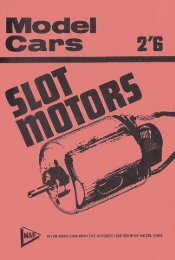You also want an ePaper? Increase the reach of your titles
YUMPU automatically turns print PDFs into web optimized ePapers that Google loves.
Figure 25: M o d d in g the b ru sh holder. File<br />
d o w n (sh a d e d area) until only 1/64 in.<br />
rem ains below bru sh hole.<br />
Check that the brush will easily slide through the brush holder,<br />
otherwise deburr the edges with a square file. With the complete<br />
bullet plates on, check for alignment by sticking in a piece of 3/32 in<br />
square tubing through the whole assembly.<br />
Variations on a theme: if you wish, skip filing down the brush holder<br />
and instead cut a slot in the plate so that the unmodified brush<br />
holder can protrude down into the Vee. Solder as before.<br />
To have even more efficient heat dissipation, your bullet proofing<br />
plates can be done 'elephant ear' size, sticking out a good bit from<br />
the endbell. This is dependent on how much space you have in the<br />
chassis. It won't look pretty, but it's efficient.<br />
A rather primitive form we invented about a year before 'real'<br />
bullet proofing became the vogue, was to solder a piece of braid to<br />
clip and brush holder. This piece is allowed to stick out a good bit<br />
and will dissipate heat surprisingly efficiently.<br />
Concerning the bearing, use either a Mura or a Champion bearing,<br />
according to the endbell make. A Mabuchi bearing will quickly develop<br />
an oval hole, so I cannot recommend it.<br />
Bullet proofing the bearing is frequently done. Either remove the<br />
outside edges around the bearing hole screw on the plate and apply a<br />
few quick dabs of solder, or reverse the bearing and solder it to the<br />
plate from the outside. See photos. As with the case bearing, polishing<br />
the inner surface to a high gloss is advisable. Bullet proofing the<br />
bearing is usually only done on can drive' motors.<br />
★ ★ ★ ★<br />
21 brushes & springs<br />
With that, we have completed the requirements for the first two<br />
items, bearing and heat proofing. Remains securing the current<br />
conduction.<br />
On a stock endbell. the current will go via the spring and via<br />
contact between brush and brush holder. The latter is rather erratic<br />
when the brush is vibrating during running, and the increased current<br />
through the spring will heat it up and make it lose pressure.<br />
What to use here is shunted brushes, meaning that the current will<br />
go directly from lead wire joint via the shunt to the brush. Shunted<br />
22






